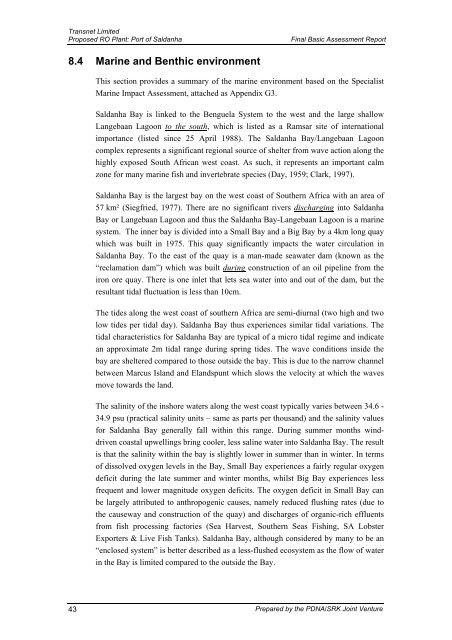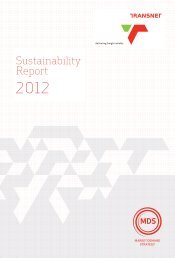Basic Assessment Report - Transnet
Basic Assessment Report - Transnet
Basic Assessment Report - Transnet
You also want an ePaper? Increase the reach of your titles
YUMPU automatically turns print PDFs into web optimized ePapers that Google loves.
<strong>Transnet</strong> LimitedProposed RO Plant: Port of SaldanhaFinal <strong>Basic</strong> <strong>Assessment</strong> <strong>Report</strong>8.4 Marine and Benthic environmentThis section provides a summary of the marine environment based on the SpecialistMarine Impact <strong>Assessment</strong>, attached as Appendix G3.Saldanha Bay is linked to the Benguela System to the west and the large shallowLangebaan Lagoon to the south, which is listed as a Ramsar site of internationalimportance (listed since 25 April 1988). The Saldanha Bay/Langebaan Lagooncomplex represents a significant regional source of shelter from wave action along thehighly exposed South African west coast. As such, it represents an important calmzone for many marine fish and invertebrate species (Day, 1959; Clark, 1997).Saldanha Bay is the largest bay on the west coast of Southern Africa with an area of57 km² (Siegfried, 1977). There are no significant rivers discharging into SaldanhaBay or Langebaan Lagoon and thus the Saldanha Bay-Langebaan Lagoon is a marinesystem. The inner bay is divided into a Small Bay and a Big Bay by a 4km long quaywhich was built in 1975. This quay significantly impacts the water circulation inSaldanha Bay. To the east of the quay is a man-made seawater dam (known as the“reclamation dam”) which was built during construction of an oil pipeline from theiron ore quay. There is one inlet that lets sea water into and out of the dam, but theresultant tidal fluctuation is less than 10cm.The tides along the west coast of southern Africa are semi-diurnal (two high and twolow tides per tidal day). Saldanha Bay thus experiences similar tidal variations. Thetidal characteristics for Saldanha Bay are typical of a micro tidal regime and indicatean approximate 2m tidal range during spring tides. The wave conditions inside thebay are sheltered compared to those outside the bay. This is due to the narrow channelbetween Marcus Island and Elandspunt which slows the velocity at which the wavesmove towards the land.The salinity of the inshore waters along the west coast typically varies between 34.6 -34.9 psu (practical salinity units – same as parts per thousand) and the salinity valuesfor Saldanha Bay generally fall within this range. During summer months winddrivencoastal upwellings bring cooler, less saline water into Saldanha Bay. The resultis that the salinity within the bay is slightly lower in summer than in winter. In termsof dissolved oxygen levels in the Bay, Small Bay experiences a fairly regular oxygendeficit during the late summer and winter months, whilst Big Bay experiences lessfrequent and lower magnitude oxygen deficits. The oxygen deficit in Small Bay canbe largely attributed to anthropogenic causes, namely reduced flushing rates (due tothe causeway and construction of the quay) and discharges of organic-rich effluentsfrom fish processing factories (Sea Harvest, Southern Seas Fishing, SA LobsterExporters & Live Fish Tanks). Saldanha Bay, although considered by many to be an“enclosed system” is better described as a less-flushed ecosystem as the flow of waterin the Bay is limited compared to the outside the Bay.43Prepared by the PDNA/SRK Joint Venture
















